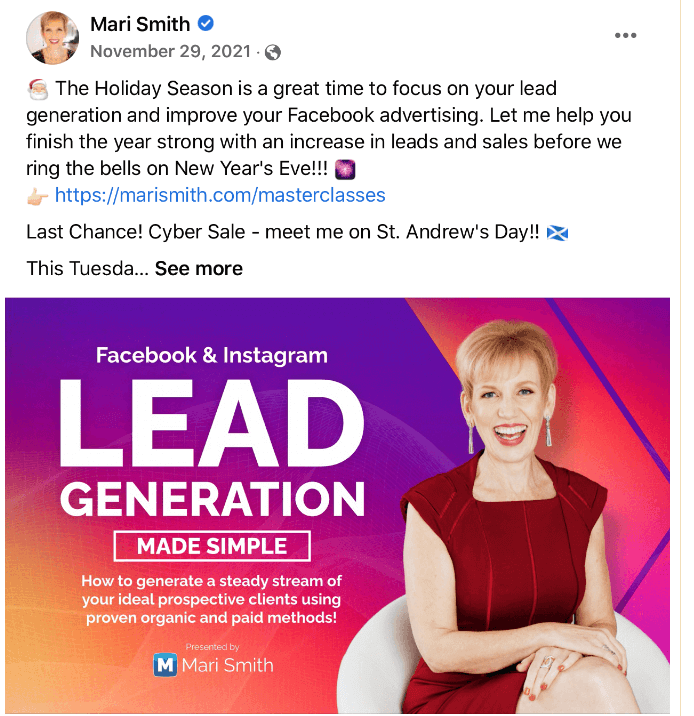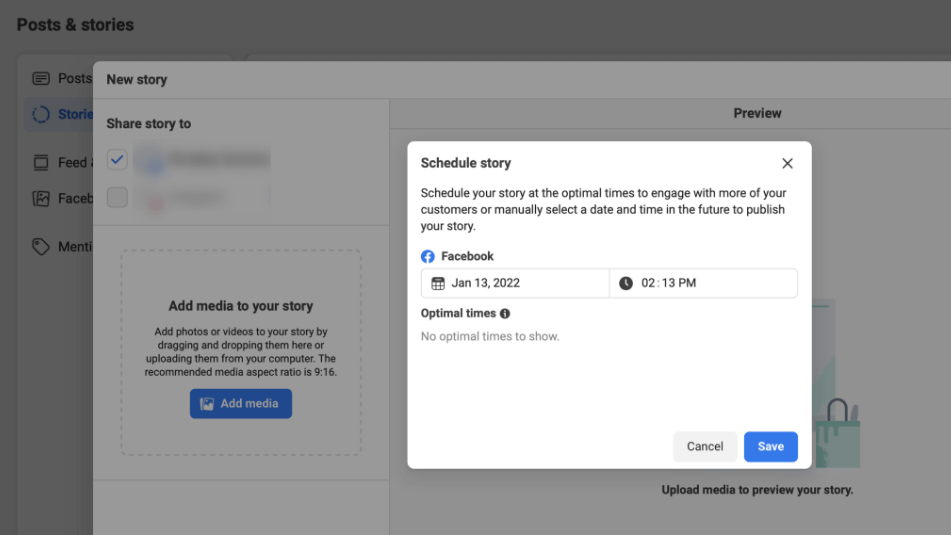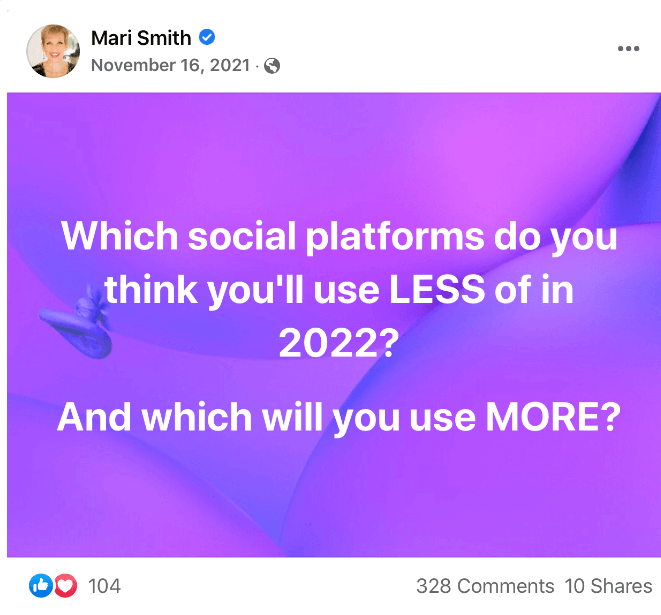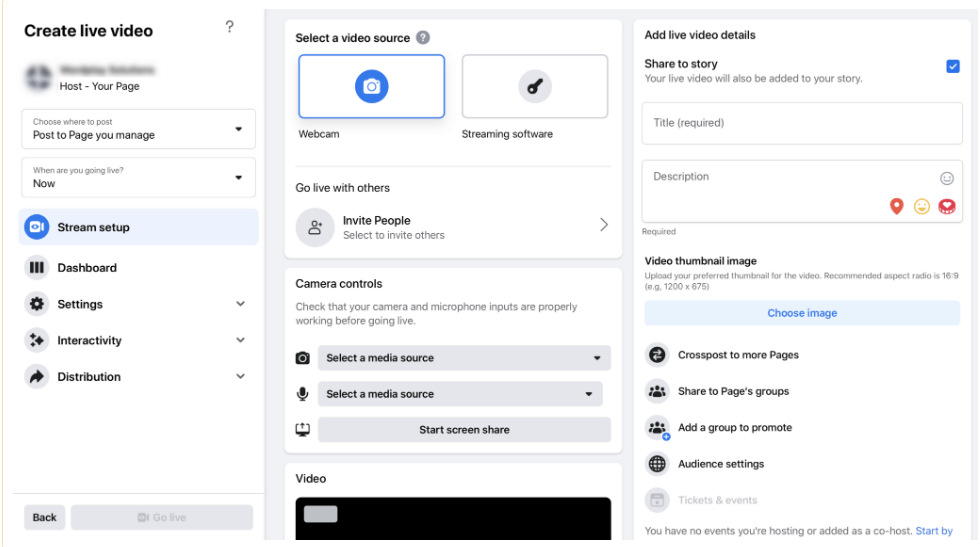Facebook organic marketing is quite hard. Business pages posts are only seen by 2 to 6% of the page’s followers. If you also see the decline in your organic Facebook metrics and want to improve your non-paid Facebook marketing, this article might help.
Does Facebook Organic Marketing Still Matter?
The diminishing organic reach that Facebook has become known for appears to have disenchanted many advertisers and companies. However, before you assume that Facebook has gone entirely pay-to-play, it’s crucial to realize what Facebook is.
Even after more than 15 years, Facebook remains the world’s largest social media network. Facebook has been engrained in the routines of over 2 billion active users; many of them are dedicated, habitual users who log in every day to spend time on the platform.
Whatever your target audience is, there’s a good chance they’ve used and continue to use Facebook. Thus, when it comes to organic social media marketing, you can’t ignore Facebook. One of the most important things to know about Facebook as a platform is that- it is very visual, much like Instagram. Not only do people respond to and engage with visual postings (such as photographs and videos), but the algorithms also appear to prefer visual content.
As a result, if you’re one of the marketers who is still hoping that video will go away, we can assure you that it isn’t going anywhere anytime soon. People prefer to receive information in a visual format, and video is one of the most effective visual methods for doing so.
Let’s Understand Facebook Algorithm:
Organic reach for personal pages is simple. This makes organic Facebook marketing a little challenging. You could get dozens of reactions and comments if you post a picture of your newborn or recent vacation, or if you write a tirade. You can increase your personal page’s reach by simply publishing native content (not external links, but instead text, images, and videos).
Most people don’t accept friend requests from people they don’t know since they aren’t seeking to utilize their Facebook profiles to build their professional brand.
Of course, people are increasingly using their Facebook profiles for commercial purposes, but this is limited to small business owners and solopreneurs.
Why is Organic Facebook Marketing Unique?
Enough with the bad news about algorithms. Let’s look at some aspects that make Facebook a unique and worthwhile location to spend time and resources for content teams. Facebook Groups and Facebook Watch are the two excellent options right now. With them, Facebook organic marketing becomes a breeze!
The popularity of Facebook groups is skyrocketing.
They’ve been putting a lot of effort into advertising their Groups recently. They view this as a way to distinguish apart and build user loyalty. They’ve been running ads all over the internet for their Groups function.
Furthermore, posts from groups are appearing in the news feed considerably more frequently than before. These aren’t simply postings from friends; they’re also posts from persons in the common group with whom the user isn’t otherwise associated.
The Facebook algorithm will show postings to members in their newsfeed if you have a Facebook group with countless of activity and interactions. That’s cool. Users will be reminded to visit your Facebook group to check what’s new if they notice such postings. To promote your top material, use the header of your Facebook group and new posts.
Businesses have a lot of potential with Facebook Watch.
Facebook video is the other major possibility. Facebook Watch is just a section of Facebook where users can watch videos from all of the businesses they follow.
It’s become the only way to see postings from Facebook pages in a convenient manner. It’s virtually the same as not being on Facebook if you’re not making videos. Users can navigate through videos in Facebook Watch to locate ones they wish to watch or click on Facebook pages they follow on the right-hand side to find new films from their favorite sites.
What to Publish on Your Facebook Page?
What should I publish on my Facebook page? It is important to pay attention to all of the many sorts of content you can publish on Facebook when it comes to organic marketing and reaches. Several, if not all, of these forms of material, will be used in a well-rounded content strategy. Although Facebook favors and promotes its newest features, you can’t overlook the impact of some of the classic post kinds that have been there for years.
#1 Facebook Image Posts
Images are still one of the most popular types of posts you can make on Facebook. Images can be made up of generated images and text created in graphics software or editors, pictures, or a combination of the two. An image post is intended to stand out from the text that dominates the Facebook home feed’s background.
When it comes to photos, many marketers make the mistake of believing they can’t include a call to action (CTA) or a link. They frequently include a call to action (CTA) in the initial comment. However, the issue is that after sharing the post the link is no longer tied to the image in any manner.
Another thing to consider is that most social media users do not read the text. You want your graphic to convey the entire story in one image because they’re browsing through their social media feeds looking for anything interesting.
This usually entails a visually appealing image with an engaging headline embedded in the graphic. You can use the language in your caption to support and augment anything in your graphic.

#2 Facebook Stories
When it comes to Facebook organic marketing, stories on Facebook could be quite helpful. Stories appear to be ubiquitous these days, with practically every platform experimenting with or relying heavily on their version. Of course, Facebook stories are full-screen vertical photographs and videos that present a tale to your viewers.
With so much stuff out there, it’s only natural to share your narrative across numerous platforms, and Instagram and Facebook have made it simple to do so. Additionally, many of the stickers and features available in the Instagram story creator will remain attached and functional once the story is shared on Facebook if you utilize the Instagram Creator.
One good method is to post one to three stories at a time, ensuring that at least one story is active in every given 24-hour period. This will keep your brand at the forefront of people’s minds, and at the top of their news feeds.
It’s also becoming easier to write stories. You can make them on the desktop and mobile versions of the Facebook app, and you can also schedule them from the desktop and mobile versions of Business Suite. Of course, if you prefer to use the Instagram story builder, you can continue to do so and then cross-post your stories to Facebook.

There’s no option to save your Facebook stories as highlights on your page yet, but the platform is starting to send them out to personal timelines. It’ll only be a matter of time until those similar highlight elements appear on business pages. When it comes to the type of content you should focus on for stories, a solid combination of personality and behind-the-scenes content can help you create and strengthen your relationship with your audience.
#3 Facebook Link Posts
Now for the important stuff: link posts. Any post, whether or not it contains a visual, that includes a link in the caption that directs traffic to a specific location, whether on Facebook or elsewhere, is considered a Facebook link post. Most marketers and brands worry about this post type since driving attention to our offers is how we keep our businesses afloat.
Because we all know Facebook loves to keep individuals on the platform for as long as possible, this is sometimes another missed chance. As a result, posts with links tend to have a lower reach and fewer impressions. Many advertisers are dissatisfied with the way their news feeds are being suppressed.
It’s ridiculous to believe that you should never post a link on Facebook since skilled marketers want to construct a strategic strategy that includes pulling together information from all of their channels.
You should, however, be strategic with those links and utilize them rarely. You can drive the link down with a lengthier caption for links to other news sources and resources your audience might find interesting—but for which you have no personal stake in whether they click the link—so that they have to click the See More link before they even see the link. Clicking on the See More link increases interaction with your post. If you’re in the middle of a launch or have a big announcement to make, you’ll want that link to be above the fold. Before someone needs to click See More, you want it to appear and be clickable.
Another option is to disable the usage of open graph information to populate your post when you insert a link on Facebook. When you include a link in a post, Facebook will frequently fetch open graphic elements such as the image to publish, especially with blog posts and articles. Even though there is a picture attached, Facebook’s algorithm labels this as a link post.
However, if you submit the image first and then add the link in the caption, Facebook can not get the open graph data, so it becomes an image post with a link, which has a better chance of being seen by the algorithms. You don’t want to share links to every post or every day, so keep that in mind. Attempting to push visitors away from Facebook every day, even if it isn’t necessarily going back to your site, is a surefire method to kill any reach your page may have.
#4 Text-Based Posts
Facebook offers a new post type that functions similarly to a text-based post, with the caption serving as the post and no further content. They now have the option, like many photographs, to build a background to assist that text stand out.
Some of these backgrounds even allow you to use your Facebook-generated avatar. While the number of backdrops you may choose from is limited- if you’re looking for something quick and easy to post, this is an excellent alternative. It combines the appealing of a vivid, scroll-stopping image with the searchability of text.

These text-based posts are useful for quick engagement articles like fill-in-the-blanks or true-or-false questions that you want a lot of feedback on. The reach is greater than that of traditional text-based posts and even more than image-based ones. Keep in mind, though, that if your text is too long and a See More link is generated, the post may not always look right when enlarged to accommodate all of the material.
#5 Reels on Facebook
Most users are now seeing Instagram reels on their Facebook page, which are a carousel block of the few reels that can be scrolled through. In addition, Facebook is gradually making the feature more available within its app.
However, for the time being, the Instagram Reels app is the more extensive builder, allowing you to identify relevant trends, music, and many of the other tools you’ll need to make your reel. If you’re interested in posting reels but think you need to do the latest dance moves or make the most trendy pointing motions, you’re mistaken. You can be quite successful by putting your twist on a trend or tying it to your business in a way that does not include dancing.
#6 Use Uploaded Video
One of the Facebook marketing strategies is to use uploaded videos. The uploaded or pre-recorded video is the next option on the list of post types you can use on Facebook. This is a video that was filmed and altered outside of the Facebook app before being uploaded to Facebook natively. It’s not always a video that stays up after you’ve finished live-streaming it.
Surprisingly, long-form videos (three minutes or more) typically outperform shorter videos. When it comes to natively posted videos, vi 5 minutes or longer videos perform the best. You should include a clear CTA in both the video and the caption that goes along with it. This is to ensure that, similar to photos, if the video is highly shared, your CTA and link will be widely shared as well.
#7 Facebook Live Video
Live videos are streamed to Facebook, and you can choose to delete the live stream or leave it on Facebook as a native video when they’ve finished. You can either use Facebook’s software or one of the many third-party apps available. One of the benefits of live streaming on Facebook with third-party software is the opportunity to improve interaction by displaying comments immediately on the screen.
Live videos allow you the opportunity to connect and engage with your audience in real-time, which is a deeper connection than many other organic postings. And by displaying those comments, you’re enhancing the interactivity even more.

In terms of the type of content, you want to broadcast live, taking industry news, especially something that’s just breaking, and going live with your comments on it appears to work across a wide range of niches. This gives your readers a fresh perspective while also allowing them to learn more about the breaking news.
#8 Facebook Live Audio Rooms
Facebook has been rolling out live audio rooms. This functionality is already available in many Facebook groups, and a few authors have it on their timelines. A live audio room has the advantage of allowing you to connect in real-time with a genuine voice without needing to be camera-ready, put-together, or “presentable.”
One thing that has been abundantly evident in recent years is that people prefer the connection to the content. They tolerate and put up with visuals and films that speak directly to them, but they want a chance to participate in the dialogue and approach and speak with you as a brand or marketer. They can do so in live audio rooms.
Another significant benefit is that when you start a live audio room, it automatically produces a post on your timeline that people can see in their news feed, letting them know you’re online and accessible to speak. They may opt to enter the audio room at that moment or leave a remark, which you can see if you return to the post outside the room.
#9 Facebook Podcasts
Last but not least, Facebook is providing a new distribution and audience-building avenue for podcasters. If you already have a podcast, you can connect it to Facebook to make it available to its users. Once again, this creates a post right in the Facebook news feed that directs people to your podcast episode and allows them to listen to it.
Furthermore, the podcast will continue to play even if you close the Facebook app to do something else, so you won’t be confined to Facebook to listen to your favorite podcast episodes. One of the most significant benefits of having your podcast streamed on Facebook is that- it allows your listeners to save and share their favorite excerpts from your show. By delivering value to those who are currently listening to your podcast, you can reach an even wider audience.
Takeaway:
Facebook is working to improve quality standards so that users can have better experiences and marketers can have stronger ties with their fans. To service your audience and expand your business, your brand needs to take advantage of this by committing to creating outstanding content and effective interaction methods. When it comes to Facebook Organic Marketing tactics, it is better to pick professionals. Hiring the best digital marketing company is a smart move. One of the best digital marketing companies knows how to perform Facebook marketing strategy to increase the reach and ensure there are beneficial results.





